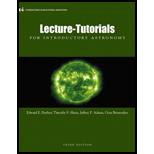
Imagine that you need to completely stop the motion of the spaceprobe and have it remain at rest while you perform a shutdown and restart procedure. You have decided that the best place to carry out this procedure would be at the position where the net (or total) gravitational force on the spaceprobe by Mars and Earth would be zero. On the diagram, label the location where you would perform this procedure. (Make your best guess; there is no need to perform any calculations here.) Explain the reasoning behind your choice.
Learn your wayIncludes step-by-step video

Chapter 2 Solutions
Lecture- Tutorials for Introductory Astronomy
Additional Science Textbook Solutions
Physics (5th Edition)
Life in the Universe (4th Edition)
University Physics Volume 2
Physics for Scientists and Engineers: A Strategic Approach, Vol. 1 (Chs 1-21) (4th Edition)
Glencoe Physical Science 2012 Student Edition (Glencoe Science) (McGraw-Hill Education)
University Physics with Modern Physics (14th Edition)
- You land on a strange spherical planet X. As a curious physicist, you set out to make the following measurements: (1) you observe that planet X has no appreciable atmosphere, (2) you measure that if you throw a 0.25 kg stone vertically upwards with launch speed 10 m/s, it comes back to ground in 8 sec, and (3) you measure the equatorial circumference to be 250,000 km. What is the mass of planet X? [Hint: The value of g on the planet surface is related to its mass M and radius R by the formula g = GM/R2.] a) 9*1025 kg b) 2.3*1027 kg c) 6.9*1026 kg If you take your spaceship to a 10,000 km altitude circular orbit around planet X, what would be the orbital period of the spaceship? [Hint: Use the fact that the gravitational force causes the radial acceleration to calculate the orbital speed.] a) 4.89 hrs b) 9.78 hrs c) 19.56 hrsarrow_forwardYour astronaut twin brother is exploring a planet of a star far out in space. Ignoring the time spent exploring the planet (during that time your watches run equally fast) also ignoring the time spent getting up to cruising speed, and slowing down for landing, (after all those times are very short compared to the time cruising,) how fast will that space ship have to cruise in order for your brother to age 2 years for every year you age?arrow_forwardWhich object orbits Earth in both the Earth – centered (geocentric) and Sun – centered (heliocentric) models of our solar system?arrow_forward
- How far (in km) is 1 lightyear (ly) – the distance travelled by light in one Earth year? Use 299,732 km/s for the speed of light (c) and 1 year = 365 days. Show your solution and write your answer in both regular notation and scientific notation.arrow_forwardExplain semiclassical gravity from every respect?arrow_forwardwhat is the physical significance of gravitational field and why it is important?arrow_forward
- At its closest approach to the sun (perihelion), Mars is approximately 2.07 E 8 km away from our closest star. At aphelion, the point furthest away in its orbit, Mars is approximately 2.49 E 8 km away. Which of the following is a true statement? 1. At aphelion, Mars is traveling at its highest speed. 2. At perihelion, Mars is traveling at its highest speed. 3. The speed at aphelion and perihelion are equal. 4. At perihelion, Mars is traveling at its lowest speed.arrow_forwardIn what ways did the astronomical observations of Galileo support a heliocentric cosmology? Describe in detail at least two specific examples.arrow_forwardHow does gravity work, and what is its importance?arrow_forward

 AstronomyPhysicsISBN:9781938168284Author:Andrew Fraknoi; David Morrison; Sidney C. WolffPublisher:OpenStax
AstronomyPhysicsISBN:9781938168284Author:Andrew Fraknoi; David Morrison; Sidney C. WolffPublisher:OpenStax Stars and Galaxies (MindTap Course List)PhysicsISBN:9781337399944Author:Michael A. SeedsPublisher:Cengage Learning
Stars and Galaxies (MindTap Course List)PhysicsISBN:9781337399944Author:Michael A. SeedsPublisher:Cengage Learning Foundations of Astronomy (MindTap Course List)PhysicsISBN:9781337399920Author:Michael A. Seeds, Dana BackmanPublisher:Cengage Learning
Foundations of Astronomy (MindTap Course List)PhysicsISBN:9781337399920Author:Michael A. Seeds, Dana BackmanPublisher:Cengage Learning




